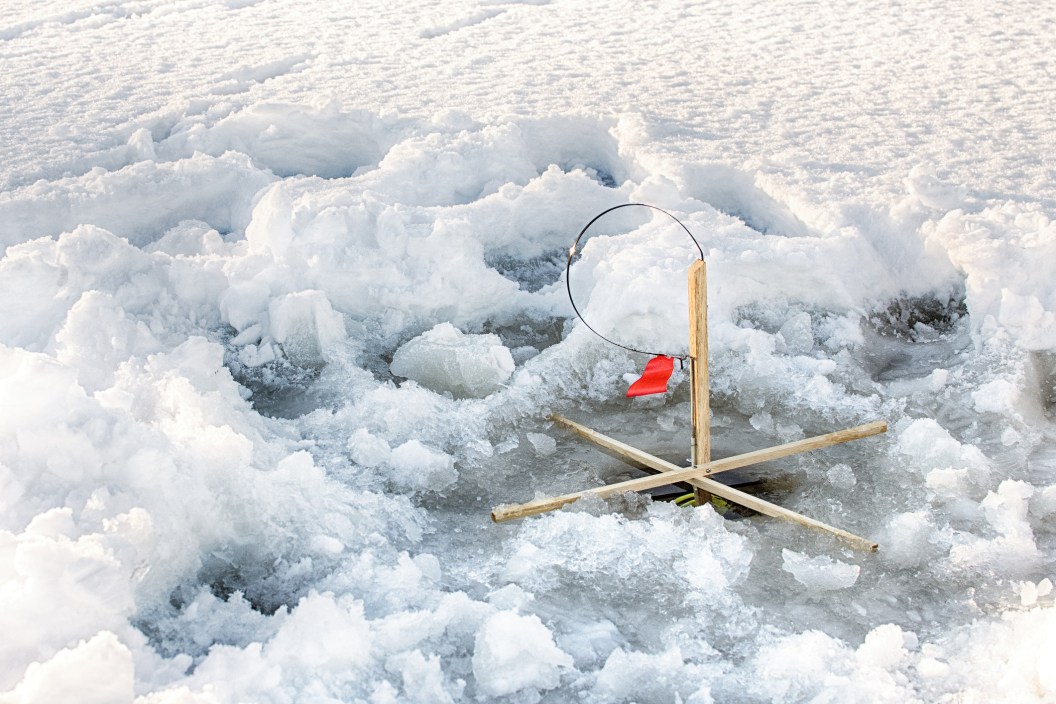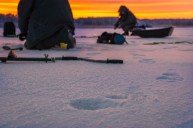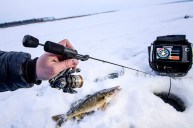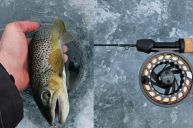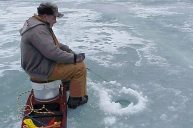Temperatures are plummeting, lakes are freezing over, and ice anglers are making moves. It's getting to be that time of year when the hardiest of anglers take to the frozen water to coax fish from holes. It's almost ice fishing time!
Tip-up ice fishing is a method used by many fishermen on the ice. It involves using devices called tip-ups, which suspend a baited hook on a fishing line through a hole in the ice. The devices have a mechanism that alerts anglers to action, usually by a flag that pops up when a fish bites the hook. Multiple tip-ups can be spaced out across an area, giving the fishermen a greater probability of catching fish. More bait and hooks in the water equals (hopefully) more fish on hooks. Tip-ups work great for perch, crappie, and other panfish, as well as big fish such as walleye and northern pike.
Tip-up ice fishing can be intimidating for beginners, but it doesn't have to be. Wide Open Spaces hit up expert ice angler Jerrod Vila to demystify this frosty wintertime fishing method.
How to Ensure Ice Thickness
The most important thing is to first ensure that the ice is safe to venture onto. The general rule is that ice needs to be 4 to 5 inches thick before it is safe to ice fish on. Most state regulatory agencies will release a statement when the ice is ready, but anglers can also check it themselves with an ice auger. Remember that accidents can happen. Always wear an ice pick or ice safety spikes in case of an unforeseen fall.
Be aware of what different ice conditions look like. Ice thickness can vary from one section to another, so be aware of the changes if moving around. Soft ice has a cloudy, white, gray, dark, or porous appearance, while thick (safe) ice looks clear black or has a bluish tint.
Vila suggests using a spud bar, which is a long, sturdy metal rod used primarily to check ice thickness and safety. Give the ice a solid whack every other step.
In some extremely cold, subzero conditions, tip-up ice holes will freeze over. That prompted the marketing of "thermal tip-ups," which place a cover over the hole and keep it from re-freezing.
Ice Fishing Gear You'll Need
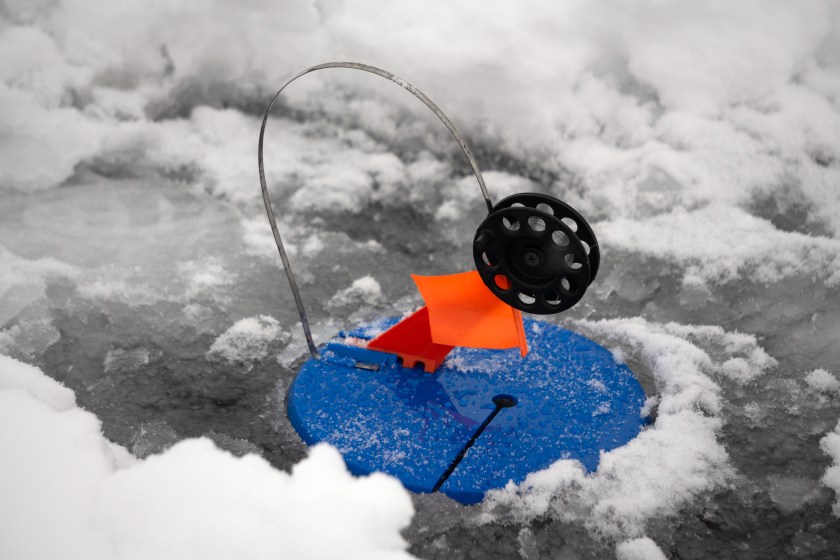
Getty Images, Vitaly Faritovitch
Tip-up ice fishing requires specific equipment. Each item has a certain purpose.
Ice Fishing Tip-Ups: Tip-ups are typically constructed of wood or plastic and are designed to suspend a fishing line with a baited hook through an ice hole drilled in fish-friendly areas of the water body. A flag is fastened to a spring-loaded trigger mechanism that releases when it is bitten by a fish. The fisherman is alerted to activity when the flag springs up. It's a convenient level of functionality to conserve time and energy.
There is a wide variety of tip-ups on the market. Some tip-ups have a bell that alerts anglers to a bite, and some high-end tip-ups send a text to alert the angler of activity. Using a non-visual signal such as a bell or text is a good option for anglers who prefer to wait for action from the inside of an ice fishing shelter.
Tip-up ice fishing does not use a rod or reel; so once a fish has taken a bite, the angler pulls in the fish by hand. Fishing line for tip-ups can vary, but Vila suggests a braided nylon, or Dacron, main tip-up line attached to a fluorocarbon leader. For the main line, Vila runs Cortland Line Company Micron Fly Line Backing in 20-pound test.
The length and pound test of the leader will vary depending on the species you're targeting. For targeting smaller fish—such as panfish, perch, or crappie—Vila suggests a 5-to-6-foot leader in the 6-to-8-pound range with a small No. 12 to No. 14 treble hook. Some waterways don't allow trebles; so in that case, a No. 8 single will work fine.
For larger fish—such as pike, walleye, or lake trout—try a 10-to-12-pound fluorocarbon leader of the same 5-to-6-foot length.
"To target pike specifically, that's when things change up," Vila said. "Many ice fishermen will swear they need to use steel leader for pike. Not the case. Thirty-pound fluorocarbon will handle any pike out there. You will indeed get an occasional bite off, but the overall amount of takes with fluorocarbon versus steel outweigh that fact by a landslide."
Shorten up the leader to 3 or 4 feet of heavy fluorocarbon when targeting pike.
Ice Auger: Ice augers are used to pierce through the ice to access the water below. Augers come in either manual or motorized styles. Manual augers are powered by elbow grease and are a more cost-effective option. Motorized augers are powered by a motor, typically either electric or gas. This option is quicker and less labor-intensive, but motorized augers do generally cost more than manual augers. Another common option is a cordless drill with an ice auger adapter.
Sounder: A sounder is a device used by ice anglers to determine water depth. This is important because most tip-up ice fishing rigs will be suspended between 6 to 12 inches off the bottom of the lake.
How to Bait for Tip-Ups
A popular method for tip-up ice fishing is to use live bait. Tip-ups are unlike a traditional ice fishing rod and reel combo, where the angler can jig the pole up and down to entice the fish. Tip-ups are immobile structures. Live bait creates the motion that attracts fish to bite.
Depending on where they are located, many anglers use smelt, suckers, shiners, minnows, and shad fish. Artificial lures are not unheard of in the tip-up space, but they're a lot less common.
It is not uncommon to have to wait several hours for a bite on tip-up. Avoid dead bait by rebaiting the line every hour or two. This will optimize movement and produce the best results.
How to Keep Warm on the Ice
Ice fishing is a cold weather activity. Between subfreezing temperatures, wind exposure from being on an icy lake surface, and harsh weather conditions, anglers can become chilled quickly. Two elements make the difference in staying comfortable while ice fishing: good apparel and a quality ice shelter.
Many retailers make high-quality cold weather fishing apparel. There are many options; but when compiling cold weather apparel, make sure to include some basics such as bibs, jacket, insulated footwear with good traction, comfortable gloves, a warm hat, face protection, and a good base layer.
Beyond proper clothing, many ice anglers employ the use of ice shelters.
Ice shelters, often called shanties, are portable structures that are hauled onto the ice and set up—either for a day or sometimes for the season—to block the wind and keep anglers safe and sheltered. Some anglers also set up portable heaters inside the shelters for added warmth.
Tip-up ice fishing can be a fantastic way to get outdoors in the winter months and scratch the itch for some fun fishing action down a deep ice hole. Proper preparation should ensure a safe, comfortable, and successful first season using tip-ups for ice fishing. The best ice fishing tip-ups for one angler might be different for another, so try some out and determine what you prefer.
